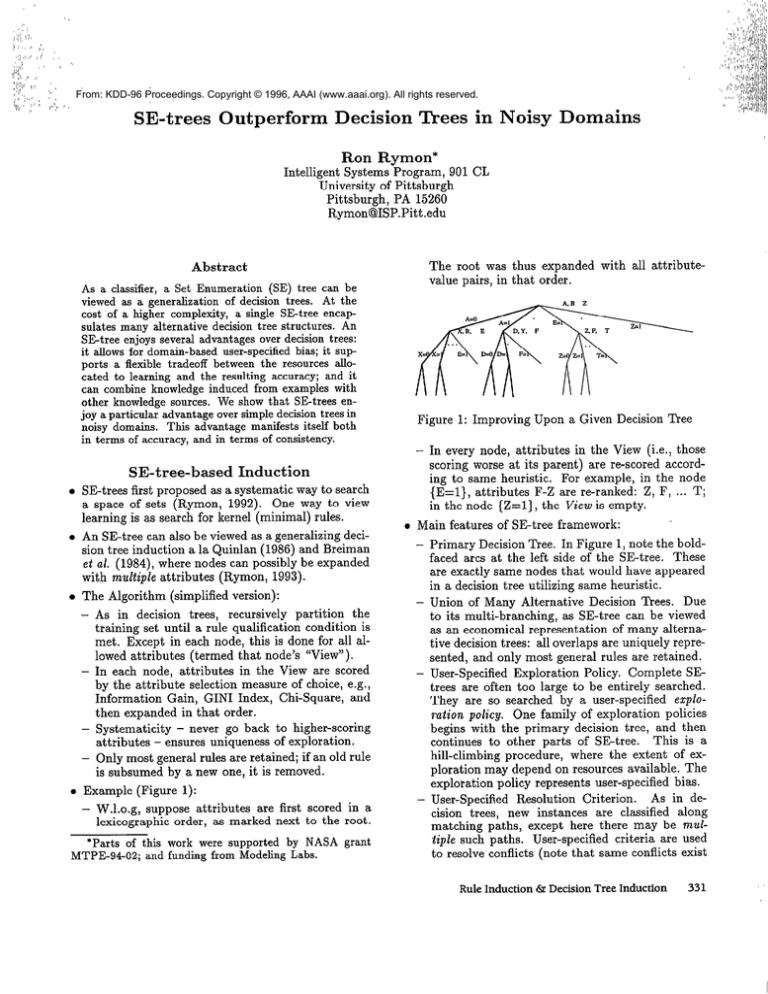
From: KDD-96 Proceedings. Copyright © 1996, AAAI (www.aaai.org). All rights reserved.
SE-trees
Outperform
Decision
Trees in Noisy
Domains
Ron Rymon*
Intelligent Systems Program, 901 CL
University of Pittsburgh
Pittsburgh, PA 15260
Rymon@ISP.Pitt.edu
The root was thus expanded with all attributevalue pairs, in that order.
Abstract
As a classifier, a Set Enumeration (SEj tree can be
viewed as a generalization of decision trees. At the
cost of a higher complexity, a single SE-tree encapsulates many alternative decision tree structures. An
SE-tree enjoys several advantages over decision trees:
it allows for domain-based user-specified bias; it sup-
ports a flexible tradeoff between the resources allocated to learning
and the resulting
accuracy;
and it
can combine knowledge induced from examples with
other knowledge sources. We show that SE-trees enjoy a particular advantage over simple decision trees in
noisy domains. This advantage manifests itself both
Figure 1: Improving
in terms of accuracy, and in terms of consistency.
SE-tree-based
- As in decision trees, recursively partition the
training set until a rule qualification condition is
met. Except in each node, this is done for all allowed attributes (termed that node’s “View”).
- In each node, attributes in the View are scored
by the attribute selection measure of choice, e.g.,
Information Gain, GIN1 Index, Chi-Square, and
then expanded in that order.
- Systematicity - never go back to higher-scoring
attributes - ensures uniqueness of exploration.
- nnlTr
mnct. b”I’
GPnPral
lwle9 -*27-P _“.,
rdnind~
if ;I.n Q!d rlJ!e
.J”-‘J
lll”YU
“ILYVI
A..Ayy
.-.----‘,
is subsumed by a new one, it is removed.
Example (Figure 1):
- W.l.o.g, suppose attributes are first scored in a
lexicographic
order,
as marked
next
to the root.
*Parts of this work were supported by NASA grant
MTPE-94-02;
- In every node, attributes in the View (i.e., those
scoring worse at its parent) are re-scored according to same heuristic. For example, in the node
{E=l}, attributes F-Z are re-ranked: Z, F, . . . T;
in the node {Z=l}, the View is empty.
Induction
SE-trees first proposed as a systematic way to search
a space of sets (Rymon, 1992). One way to view
learning is as search for kernel (minimal) rules.
An SE-tree can also be viewed as a generalizing decision tree induction a la Quinlan (1986) and Breiman
ei al. (1984), where nodes can possibly be expanded
with multiple attributes (Rymon, 1993).
The Algorithm (simplified version):
and funding from Modeling
Labs.
Upon a Given Decision Tree
l
Main features of SE-tree framework:
- Primary Decision Tree. In Figure 1, note the boldfaced arcs at the left side of the SE-tree. These
are exactly same nodes that would have appeared
in a decision tree utilizing same heuristic.
^--- i-ub~lllc&bIYt:
,a,&___^A:.., l-l,,:,:,,
- TT-I-“II,“11 “I-c xx
NLally
U1;1.13L”l‘q-L,.,.,
11GG3. Due
to its multi-branching,
as SE-tree can be viewed
as an economical representation of many alternative decision trees: all overlaps are uniquely represented, and only most general rules are retained.
- User-Specified Exploration Policy. Complete SEtrees are often too large to be entirely searched.
They are so searched by a user-specified exploration policy. One family of exploration policies
begins with the primary decision tree, and then
This is a
continues to other parts of SEtree.
hill-climbing procedure, where the extent of exploration may depend on resources available. The
exploration policy represents user-specified bias.
- User-Specified Resolution Criterion.
As in decision trees, new instances are classified along
matching paths, except here there may be multiple such paths. User-specified criteria are used
to resolve conflicts (note that same conflicts exist
Rule Induction 6r Decision Tree Induction
331
Figure 3: Varying #lits, #conj=20
Problem size: 10 binary attributes + binary class.
Training set size: 25% of the domain.
Complexity of target function: using DNF representations, diversity is achieved by varying the
number of conjunctions (#conj), and the number
of literals per conjunction (#lits).
Distribution of problems: Uniform over a given
choice of #conj and #lits.
Choice of decision tree program: Information Gain
(ID3) is used to select splitting attributes.
Choice of parametrization for SE-tree framework:
* Exploration policy and extent: Complete SEtrees only (conservative assumption).
* Resolution criterion: Simple voting (again a conservative assumption).
- Pruning: Unpruned trees.
between alternative decision trees). A resolution
criterion can be general (e.g., simple voting), but
may also represent domain-based bias.
Implementation.
This family of algorithms for
SE-tree-based induction,
including a variety of
attribute-selection measures, as well as exploration
policies and resolution criteria, is implemented in a
program called SE-Learn (SE-Learn Home Page).
Hypothesis
and Methods
Hypothesis: SE-trees outperform
noisy domains.
decision trees in
Intuitive Explanation: incorporating many alternative decision trees acts to reduce variance error.
Method of Investigation:
empirical, by testing on
randomly generated artificial problem sets, with
varying noise levels. We compare generalization accuracy of SE-tree and its primary decision tree.
Using artificial problems, we can control generation
and testing parameters. For the main experiment
we use the following parameters:
332
Technology Spotlight
a In subsequent experiments, we test sensitivity to important assumptions.
Main
l
Experiment
Two experiments: varying #conj, and varying #lits.
As aside, it appears as if 20-conj 5-lits functions are
more complex than other variations.
Noise modeled as randomly assigned classes, O-100%.
Test complete SE-tree vs. primary decision tree.
30 different random probiems tested per data point.
Reporting:
- Normalized reduction in average error rates:
lOO*(Err(DT)-Err(SE))/Err(SE);
- Normalized reduction in variance:
lOO*(STD(DT)-STD(SE))/STD(SE);
- Cost as complexity ratio: Size(SE)/Size(DT).
Results (Figures 2, 3):
- Generally SE-trees have lower error rates (as indicated by positive values).
- At moderate noise levels, error reduction increases
with introduction of additional noise. By definition, it must then drop back; at 100% noise, there
is no information in training set.
- SE-trees are more consistent at moderate noise
levels, but less consistent at very high noise levels.
- Complete SEtrees are more complex. However,
they are typically explored partially. Generally,
complexity ratios are higher for more complex
functions. It appears that noise reduces the ratio
for
and increases it for simpler
--- comDlex
-----=-..~ functions,
~~~~~~
ones.
Experimental
Setting
Variations
Conservative assumption: performed with 20-conjs
5-lits functions, where the relative performance of
the SEtree was poorest: #conj=20 and #lits=5.
Alternative attribute selection heuristics (Figure 4).
No apparent differences.
Training set sizes (Figure 5). Hypothesis still confirmed.
However, lower absolute error reduction
rates and higher compiexity ratios are apparent with
fewer training instances.
Statistically pruned vs. Unpruned trees (Figure 6).
SE-tree still outperforms decision tree. However, in
pruned trees, we find smaller error reductions, and
larger variations. In pruned trees, complexity ratios
are smaller, and drop quickly with noise.
Related
Work
and Discussion
Tree averaging. As a joint representation for many
alternative decision trees, the SEtree-based framework bears resemblance to the tree averaging approach taken by Kwok and Carter (1990) and Buntine (1994), as well as Breiman’s (1994) bagging.
Reduction of Variance Error. Dietterich and Kong
(1995) distinguish statistical bias from variance error. They indicate that “one important source of
variance in C4.5 is the fact that the algorithm must
choose a single split at each node”. Noisy domains
are characterized by added variance, and SE-trees
may relieve some of it.
Dietterich and Kong conclude that “some method
is needed for converting a combination of trees (or
other complex hypothesesj into a smaiier, equivaient
hypothesis. These trees are very redundant; how can
we remove this redundancy, while still reducing bias
and variance?“. SE-trees may represent one step in
that direction.
Bootstrap Aggregation. In analyzing where bagging
works, Breiman too points to domains exhibiting
great variation between alternative classifiers. SEtrees provide an effective way to consider alternative decision trees without the loss of information
incurred when subseting the training data.
Conclusion
In the presence of noise, a complete SE-tree typically
outperforms its own primary decision tree. Results
were replicated with different heuristics.
At moderate noise levels, the SE-tree advantage generally increases with additional noise.
At moderate noise levels, the SE-tree is also more
consistent.
References
Breiman, L., Friedman, J., Olshen, R., and Stone,
C., Classification and Regression Trees. Wadsworth,
Belmont.
Breiman, L., Bagging Predictors. Technical Report
4.21, Department of Statistics, UC Berkeley.
Buntine, W., Learning Classification Trees. ArtiJiciaE
Intelligence Frontiers zn Statistics, D. Hand (Ed),
Chapman and Hall.
Dietterich, T. G., and Kong, E. B., Machine Learning Bias, Statistical Bias, and Statistical Variance of
Decision Tree Algorithms. Technical Report, Department of Computer Science, Oregon State University.
Kwok, S., and Carter, C., Multiple Decision Trees.
Uncertainly in Artificial Intelligence, 4, pp. 327-335.
Quinlan, J. R., Induction of Decision Trees. Machine
Learning, 1(1):81-106.
Quinlan, J. R., C4.5: Programs for Empirical Learning. Morgan Kaufmann, San Francisco, CA.
Rymon, R., Search through Systematic Set Enumeration. Third Innternational Conference on Principles
of Knowledge Representation and Reasoning, Cambridge MA, pp. 539-550.
Rymon, R., An SE-tree-based Characterization of the
Induction Problem. Tenth Internadional Conference
on Machine Learning, pp. 268-275, Amherst MA.
Rymon, R., Home page for the SELearn software.
http://www.isp.pitt.edu/“rymon/SE-Learn.html.
Rule Induction 6r Decision Tree Induction
333
Figure 4: Various Attribute-Selection
--.
I
Heuristics
i
h
...
Figure 5: Various Training Set Sizes
Figure 6: With and Without
334
Technology Spotlight
Pruning






